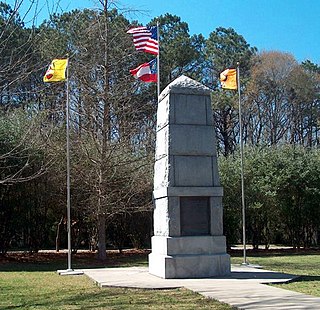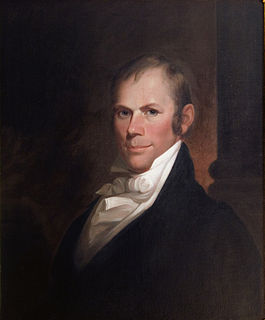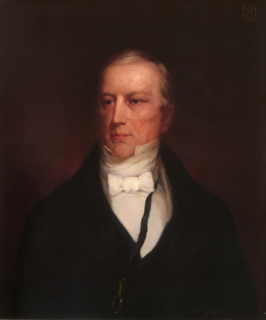
Andrew Jackson was an American lawyer, general, and statesman who served as the seventh president of the United States from 1829 to 1837. Before being elected to the presidency, Jackson gained fame as a general in the United States Army and served in both houses of the U.S. Congress. An expansionist president, Jackson sought to advance the rights of the "common man" against a "corrupt aristocracy" and to preserve the Union.

The 1832 United States presidential election was the 12th quadrennial presidential election, held from November 2 to December 5, 1832. Incumbent president Andrew Jackson, candidate of the Democratic Party, defeated Henry Clay, candidate of the National Republican Party.

Daniel Webster was an American lawyer and statesman who represented New Hampshire and Massachusetts in the U.S. Congress and served as the U.S. Secretary of State under Presidents William Henry Harrison, John Tyler, and Millard Fillmore. As one of the most prominent American lawyers of the 19th century, he argued over 200 cases before the U.S. Supreme Court between 1814 and his death in 1852. During his life, he was a member of the Federalist Party, the National Republican Party, and the Whig Party.

John Caldwell Calhoun was an American statesman and political theorist from South Carolina who held many important positions including being the seventh vice president of the United States from 1825 to 1832, while adamantly defending slavery and protecting the interests of the white South. He began his political career as a nationalist, modernizer, and proponent of a strong national government and protective tariffs. In the late 1820s, his views changed radically, and he became a leading proponent of states' rights, limited government, nullification, and opposition to high tariffs. He saw Northern acceptance of those policies as a condition of the South remaining in the Union. His beliefs and warnings heavily influenced the South's secession from the Union in 1860–1861.

The Trail of Tears was part of the Indian removal, an ethnic cleansing and series of forced displacements of approximately 60,000 Native Americans of the Five Civilized Tribes between 1830 and 1850 by the United States government. Removal for this event was gradual, occurring over a period of nearly a decade. Members of the so-called Five Civilized Tribes—the Cherokee, Muscogee (Creek), Seminole, Chickasaw, and Choctaw nations —were forcibly removed from their ancestral homelands in the Southeastern United States to areas to the west of the Mississippi River that had been designated Indian Territory. The forced relocations were carried out by government authorities after the passage of the Indian Removal Act in 1830. The Cherokee removal in 1838 was brought on by the discovery of gold near Dahlonega, Georgia, in 1828, resulting in the Georgia Gold Rush.

The Indian Removal Act was signed into law on May 28, 1830, by United States President Andrew Jackson. The law authorized the president to negotiate with southern Native American tribes for their removal to federal territory west of the Mississippi River in exchange for white settlement of their ancestral lands. The Act was signed by Andrew Jackson and it was strongly enforced under his administration and that of Martin Van Buren, which extended until 1841.
The nullification crisis was a United States sectional political crisis in 1832–33, during the presidency of Andrew Jackson, which involved a confrontation between the state of South Carolina and the federal government. It ensued after South Carolina declared the federal Tariffs of 1828 and 1832 unconstitutional and therefore null and void within the sovereign boundaries of the state. However, courts at the state and federal level, including the U.S. Supreme Court, repeatedly have rejected the theory of nullification by states.
Worcester v. Georgia, 31 U.S. 515 (1832), was a landmark case in which the United States Supreme Court vacated the conviction of Samuel Worcester and held that the Georgia criminal statute that prohibited non-Native Americans from being present on Native American lands without a license from the state was unconstitutional.
The South Carolina Exposition and Protest, also known as Calhoun's Exposition, was written in December 1828 by John C. Calhoun, then Vice President of the United States under John Quincy Adams and later under Andrew Jackson. Calhoun did not formally state his authorship at the time, though it was widely suspected and later confirmed.

The Tariff of 1833, enacted on March 2, 1833, was proposed by Henry Clay and John C. Calhoun as a resolution to the Nullification Crisis. Enacted under Andrew Jackson's presidency, it was adopted to gradually reduce the rates following Southerners' objections to the protectionism found in the Tariff of 1832 and the 1828 Tariff of Abominations; the tariffs had prompted South Carolina to threaten secession from the Union. This Act stipulated that import taxes would gradually be cut over the next decade until, by 1842, they matched the levels set in the Tariff of 1816—an average of 20%. The compromise reductions lasted only two months into their final stage before protectionism was reinstated by the Black Tariff of 1842.

John Floyd was a Virginia politician and soldier. He represented Virginia in the United States House of Representatives and later served as the 25th Governor of Virginia.

The 1832 and 1833 United States House of Representatives elections were held concurrently with the 1832 presidential election, in which Democrat Andrew Jackson was re-elected.

William J. Gaston was a jurist and United States Representative from North Carolina. Gaston is the author of the official state song of North Carolina, "The Old North State". Gaston County, North Carolina, created just after his death, was named for him, as later were the city of Gastonia, North Carolina, artificial Lake Gaston, and the splendid Gaston Hall auditorium at his alma mater, Georgetown University.

The 1832 Democratic National Convention was held from May 21 to May 23, 1832, in Baltimore, Maryland. In the first presidential nominating convention ever held by the Democratic Party, incumbent President Andrew Jackson was nominated for a second term, while former Secretary of State Martin Van Buren was nominated for vice president.

The presidency of Andrew Jackson began on March 4, 1829, when Andrew Jackson was inaugurated as President of the United States, and ended on March 4, 1837. Jackson, the seventh United States president, took office after defeating incumbent President John Quincy Adams in the bitterly contested 1828 presidential election. During the 1828 presidential campaign, Jackson founded the political force that coalesced into the Democratic Party during Jackson's presidency. Jackson won re-election in 1832, defeating National Republican candidate Henry Clay by a wide margin. He was succeeded by his hand-picked successor, Vice President Martin Van Buren, after Van Buren won the 1836 presidential election.

The second inauguration of Andrew Jackson as president of the United States took place in the House Chamber of the U.S. Capitol on Monday, March 4, 1833. The inauguration marked the commencement of the second four-year term of Andrew Jackson as president and the only four-year term of Martin Van Buren as vice president.
The 1836 State of the Union Address was given by Andrew Jackson, the seventh president of the United States, on December 5, 1836. He did not personally deliver the address to the 24th United States Congress, but a clerk did. He concluded it with, "All that has occurred during my Administration is calculated to inspire me with increased confidence in the stability of our institutions; and should I be spared to enter upon that retirement which is so suitable to my age and infirm health and so much desired by me in other respects, I shall not cease to invoke that beneficent Being to whose providence we are already so signally indebted for the continuance of His blessings on our beloved country."
The 1829 State of the Union Address was given by Andrew Jackson, the seventh president of the United States. He did not speak directly to the 21st United States Congress, but it was still important. Presented on Tuesday, December 8, 1829, in the United States House of Representatives chamber, it was his first address. He said, "In communicating with you for the first time it is to me a source of unfeigned satisfaction, calling for mutual gratulation and devout thanks to a benign Providence, that we are at peace with all man-kind, and that our country exhibits the most cheering evidence of general welfare and progressive improvement." He addressed the Natives, There the benevolent may endeavor to teach them the arts of civilization, and, by promoting union and harmony among them, to raise up an interesting commonwealth, destined to perpetuate the race and to attest the humanity and justice of this Government."
The 1830 State of the Union Address was given by the seventh United States president, Andrew Jackson on Tuesday, December 6, 1830, to both houses of the United States Congress. He said, "What good man would prefer a toe covered with forests and ranged by a few thousand savages to our extensive Republic, studded with cities, towns, and prosperous farms, embellished with all the improvements which art can devise or industry execute, occupied by more than 12,000,000 happy people, and filled with all the blessings of liberty, civilization, and religion?" He speaks of the Indian Removal Act, "With a full understanding of the subject, the Choctaw and the Chickasaw tribes have with great unanimity determined to avail themselves of the liberal offers presented by the act of Congress, and have agreed to remove beyond the Mississippi River."

The 2015 State of the Union Address was given by the 44th president of the United States, Barack Obama, on January 20, 2015, at 9:00 p.m. EST, in the chamber of the United States House of Representatives to the 114th United States Congress. It was Obama's sixth State of the Union Address and his seventh speech to a joint session of the United States Congress. Presiding over this joint session was the House speaker, John Boehner, accompanied by Joe Biden, the vice president, in his capacity as the president of the Senate.












